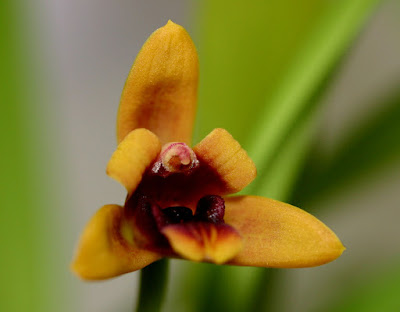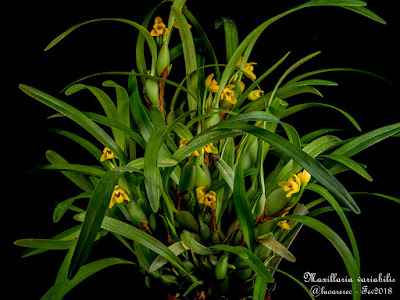Maxillaria variabilis is native to Central America from Mexico to Panama. These orchids grow on trees, on rocks or on the surface of the ground and in very different habitats. In Mexico, they meet in the states of Chiapas, Colima, Durango, Guerrero, Hidalgo, Jalisco, México...
Maxillaria variabilis also called as The Variable Maxillaria, Maxillaria angustifolia, Maxillaria chiriquensis, Maxillaria lyoni, Maxillaria panamensis, Maxillaria revoluta, Maxillaria variabilis subvar. lutea, Maxillaria variabilis var. unipunctata, Maxillariella panamensis, Maxillariella variabilis, Maxillariella variabilis var. unipunctata, is a species of the genus Maxillaria. This species was described by James Bateman ex John Lindley in 1837.
IDENTIFY MAXILLARIA VARIABILIS
Maxillaria variabilis is native to Central America from Mexico to Panama. These orchids grow on trees, on rocks or on the surface of the ground and in very different habitats. In Mexico, they meet in the states of Chiapas, Colima, Durango, Guerrero, Hidalgo, Jalisco, México, Michoacán, Nayarit, Oaxaca, Pueblo, Sinaloa and Veracruz. They grow there on oaks growing pastures, in open forests, in dense forests, at heights up to 2000 m. In Guatemala, they are found in mountainous areas throughout the country, where they grow in both open and dense, damp forests at heights up to 1900 m In El Salvador, they are found in several places at heights of 650-1400 m. In Nicaragua, he meets in the mountains north of Managua, at an altitude of 1000-1500 m.
It is a small sized, hot to cool growing terrestrial, lithophytic or epiphytic, solitary leafed species, which reaching 4-21 cm, with simple or branched rhizomes carrying subclustered, ovoid to ellipsoid, 1.3-6.4 cm long pseudobulb subtended by several sheaths and carrying a single, apical, linear or linear-oblong, subcoriaceous, grass-green acute to obtuse, 3-15 cm long leaf.
The Variable Maxillaria blooms throughout the year with several scarious sheaths that carry the slender, to 5 cm long, single flowered inflorescence enveloped by several, thin, scarious, translucent, lanceolate, acuminate bracts with variable colored, long-lasting flowers. The flowers are up to 2 cm in diameter. The color of flowers is very variable, it can be white, yellow, dark orange, greenish-yellow and sometimes dark red or red-brown. They may also have dark red spots or a red lip. Shiny, similar to the tongue shape, the thickening on the lip can be from bright red in the case of lighter flowers to almost the same color as the petals of both whorls in the case of darker flowers. The spine is usually wine-red with red and white spots at the base.
MAXILLARIA VARIABILIS CARE AND CULTURE
Cultural information should only be used as a guide, and should be to be adapted to suit you. Your physical location; where you grow your plants, how much time you have to devote to their care, and many other factors, will need to be taken into account. Only then can you decide on the cultural methods that best suit you and your plants.
Light:
Maxillaria variabilis needs a light level of 18000-30000 lux. Moderately bright light should be dispersed. Direct action of the southern sun can destroy the plant. Strong air movement should be ensured all the time.
Temperature:
The average temperature of the summer day is 27-28 ° C, the night 15-16 ° C, and the daily difference is 12-13 ° C. The average temperature of the winter day is 25-27 ° C, the night 8-10 ° C, and the daily difference is 16-17 ° C.
Humidity:
In the summer and early autumn, The Variable Maxillaria needs the humidity of 70-75%, and then from late autumn until the beginning of spring it drops to 55-60%.
Substrate, growing media and repotting:
Maxillaria variabilis can be grown in containers with good drainage or mounted on tree fern rootstock with high humidity, and in hot dry weather they may require several waterings during the day.
These plants are also grown in pots or baskets filled with very loose, quickly drying ground. Many growers use medium-sized bark or chopped tree fern fibers with pieces of pearlite, which improves the looseness of the substrate, but at the same time retains some of the moisture. Addition of pieces of charcoal also improves the airiness of the substrate and prevents it from souring.
The plants should be repotted immediately after determining that the substrate begins to decompose, or annually if the plant grows out of the pot. Repotting is best done when new roots start growing and when new growths appear, because then the plant will stabilize as quickly as possible.
Watering:
From late spring to early autumn precipitation is moderate to heavy. Then their number decreases quite rapidly and a 5-6 month period of drought begins, beginning in mid-autumn and lasting until the beginning of spring. Actively growing cultivated plants should be kept constantly moist with only slight drying between waterings. In autumn, when vegetation slows down, the amount of water should be gradually reduced.
Fertilizer:
It is recommended to apply a 1/4-1/2 dose of orchid fertilizer weekly during active growth. You can use a fertilizer that is balanced all year round. You can also use high-nitrogen fertilizer from spring to mid-summer, and then until the end of autumn high-phosphoric fertilizer.
Rest period:
Maxillaria variabilis in winter need less water, but they can not be completely dry for too long. Usually an occasional morning fogging between rare, light watering is sufficient. Such fogging should provide enough moisture to provide the necessary cool, dry rest. Fertilization should be reduced or eliminated until new growths appear in the spring and more watering starts.















COMMENTS